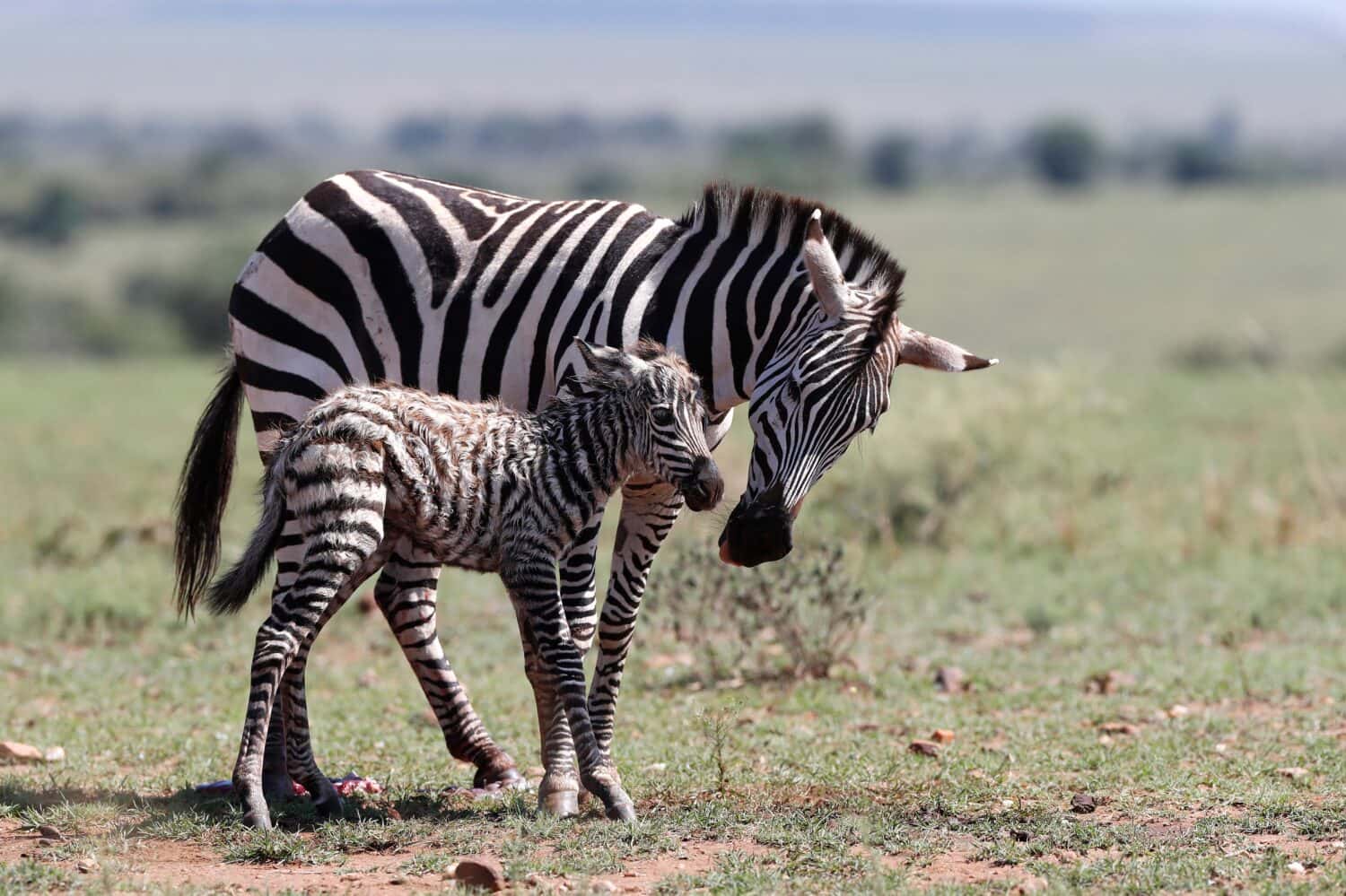Zebras are highly distinctive mammals given their signature stripes and graceful lineaments, but it can be difficult to tell males and females apart. One of the most obvious ways to distinguish between the sexes is by observing whether or not the zebra is pregnant or caring for a foal. However, in the absence of this clue, observers can rely on several other hints. In this article, we’ll examine the six key differences between male and female zebras.

Three species of zebras exist today: plains, mountain, and Grevy’s zebras.
©Chantal de Bruijne/Shutterstock.com
Summary Table of Male vs Female Zebras
| Trait | Male | Female |
|---|---|---|
| Size | Slightly larger than females within size range for species Plains zebra (species max): 8 ft and 849 lbs Mountain zebra (species max): 8.5 ft and 948 lbs Grévy’s zebra (species max): 9 ft and 992 lbs | Slightly smaller than males within size range for species Plains zebra (species min): 6.6 ft and 386 lbs Mountain zebra (species min): 6.9 ft and 450 lbs Grévy’s zebra (species min): 8.2 ft and 776 lbs |
| Anatomy | Slightly larger and more muscular with broader necks Spade-shaped canines for fighting | Slightly smaller and less muscular with narrower necks Lacks spade-shaped canines |
| Social Behavior and Temperament | More dominant and aggressive | More submissive |
| Communication | More frequent displays of dominance like flattening the ears, baring the teeth, and waving the head Mutual grooming | Typically lacks displays of dominance Will call out to foals when separated Mutual grooming |
| Roles in Raising Young | Protector of the herd | Responsible for raising young |
| Reproduction | Fights with other males for the right to mate with females Insertive sexual partner | Goes into estrus (heat) to signal readiness to mate Receptive sexual partner Bears and raises young |
Male vs Female Zebras: 6 Key Differences
Although it can be difficult to tell a male from a female zebra at first glance, several key differences exist. These include size, anatomy, social behavior and temperament, communication, roles in raising young, and reproduction. As with any animal, the surest way to tell male and female zebras apart is by sexing them, which means examining their genitals.
Size

The plains zebra is the smallest of the three species with little difference between males and females.
©Martin Prochazkacz/Shutterstock.com
Three species of zebras exist the plains zebra, the mountain zebra, and Grévy’s zebra. These species range in size, but in all three, the female tends to be slightly smaller than the male. However, the difference is more pronounced in Grévy’s zebra; in the other two species, the distinction is so small as to be negligible. Below are the lengths and weights associated with the three zebra species:
Plains Zebra
- Length: 6.6-8 ft (2-2.5 m)
- Weight: 386-849 lbs (175-385 kg)
Mountain Zebra
- Length: 6.9-8.5 ft (2.1-2.6 m)
- Weight: 450-948 lbs (204-430 kg)
Grévy’s Zebra
- Length: 8.2-9 ft (2.5-2.75 m)
- Weight: 776-992 lbs (352-450 kg)
Anatomy
Because sexual dimorphism is extremely limited in zebras, it can be difficult to tell males and females apart just by looking at them. Male zebras tend to be slightly larger and more muscular than their female counterparts; they also have broader necks. In addition to this, male zebras have spade-shaped canines that they use to nip and bite their opponents during a fight. This helps them establish dominance over other zebra males and repel predators. Of course, males and females differ greatly in their sexual anatomy: males have penises while females have vaginas and uteruses for bearing young.
Social Behavior and Temperament

Zebras gather in herds of females and foals with a single stallion.
©Shllabadibum Bubidibam/Shutterstock.com
The difference between male and female zebras is more pronounced in their social behaviors and temperaments than in their nonsexual physical anatomy. Male zebras tend to be more dominant and aggressive than females, which is partly due to their need to protect their territory from rival males and vie for mates. The male zebra in charge of the herd or harem (called a stallion) also takes on the role of herd protector. Stallions tend to hover near the back of the herd to protect the females and foals from predators.
Female zebras congregate with other females and their foals both for social reasons and for protection. They are submissive to the harem stallion and, in plains and mountain zebras, mate with him alone. However, Grévy’s zebras are more promiscuous in their mating habits.
Communication
Zebras communicate verbally in several ways including barking, braying, snorting, gasping, and squealing. They also use their lips, heads, ears, and tails to communicate a range of emotions from affection to aggression to alarm.
Mares who have become separated from their foals often call out until they find them. Stallions who wish to appear threatening will flatten their ears, bare their teeth, and wave their heads. Additionally, stallions and mares will often groom each other to express affection, as will mares and foals. During mating season, males draw back their upper lips to help them, scent females, in heat; this is called the Flehmen response.
Roles in Raising Young
Zebras are highly social animals that gather in herds to protect and raise their young. Females are in charge of child-rearing while males take a mainly protective role. However, Grévy’s zebra stallions sometimes look after the crèche (group of young zebras) while the mothers go in search of water.
Generally, Grévy’s zebra stallions are more tolerant toward the offspring of other males than are stallions of other species. This is due to their more promiscuous mating habits. Plains and mountain zebra stallions occasionally practice infanticide or feticide to get rid of other males’ offspring.
Reproduction

Female zebras are in charge of raising their young while the males act as protectors of the herd.
©Shllabadibum Bubidibam/Shutterstock.com
Female zebras enter periods of reproductive receptivity known as estrus, which lasts between five and 10 days. During this time, they give off a strong scent and indicate their readiness to mate. Nearby males pick up on these signals and, if necessary, fight for the right to mate with the females. The victorious male approaches the female and mounts her. Once the mating ritual is complete, the male withdraws.
Once the foal is born, the mare takes on the responsibility of raising it. A zebra foal is considered mature at about three years of age. At this point, male and female zebras diverge in their paths and roles. Males leave their mothers to join an all-male bachelor herd while females remain with their herd of birth. The young males eventually fight stallions for dominance and the right to mate with females.
Conclusion
The key differences between male and female zebras are size, anatomy, social behavior and temperament, communication, roles in raising young, and reproduction. Generally speaking, male zebras are slightly larger and more aggressive than females.
Thank you for reading! Have some feedback for us? Contact the AZ Animals editorial team.








